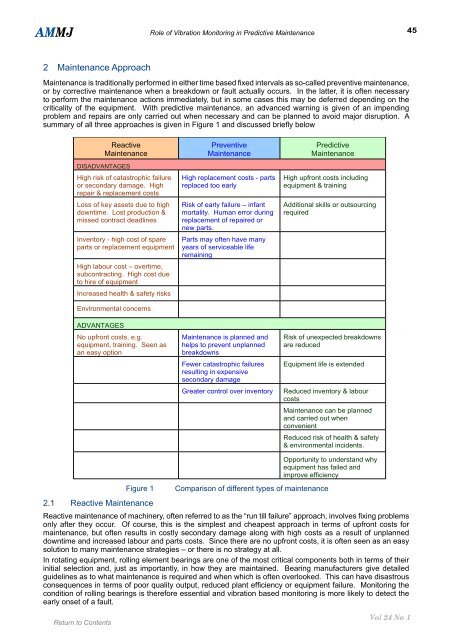AMMJ - Library
AMMJ - Library
AMMJ - Library
Create successful ePaper yourself
Turn your PDF publications into a flip-book with our unique Google optimized e-Paper software.
<strong>AMMJ</strong><br />
2 Maintenance Approach<br />
Maintenance is traditionally performed in either time based fixed intervals as so-called preventive maintenance,<br />
or by corrective maintenance when a breakdown or fault actually occurs. In the latter, it is often necessary<br />
to perform the maintenance actions immediately, but in some cases this may be deferred depending on the<br />
criticality of the equipment. With predictive maintenance, an advanced warning is given of an impending<br />
problem and repairs are only carried out when necessary and can be planned to avoid major disruption. A<br />
summary of all three approaches is given in Figure 1 and discussed briefly below<br />
Reactive<br />
Maintenance<br />
DISADVANTAGES<br />
High risk of catastrophic failure<br />
or secondary damage. High<br />
repair & replacement costs<br />
Loss of key assets due to high<br />
downtime. Lost production &<br />
missed contract deadlines<br />
Inventory - high cost of spare<br />
parts or replacement equipment<br />
High labour cost – overtime,<br />
subcontracting. High cost due<br />
to hire of equipment<br />
Increased health & safety risks<br />
Environmental concerns<br />
ADVANTAGES<br />
No upfront costs, e.g.<br />
equipment, training. Seen as<br />
an easy option<br />
2.1 Reactive Maintenance<br />
Role of Vibration Monitoring in Predictive Maintenance<br />
Preventive<br />
Maintenance<br />
High replacement costs - parts<br />
replaced too early<br />
Risk of early failure – infant<br />
mortality. Human error during<br />
replacement of repaired or<br />
new parts.<br />
Parts may often have many<br />
years of serviceable life<br />
remaining<br />
Maintenance is planned and<br />
helps to prevent unplanned<br />
breakdowns<br />
Fewer catastrophic failures<br />
resulting in expensive<br />
secondary damage<br />
Figure 1 Comparison of different types of maintenance<br />
Predictive<br />
Maintenance<br />
High upfront costs including<br />
equipment & training<br />
Additional skills or outsourcing<br />
required<br />
Risk of unexpected breakdowns<br />
are reduced<br />
Equipment life is extended<br />
Greater control over inventory Reduced inventory & labour<br />
costs<br />
Maintenance can be planned<br />
and carried out when<br />
convenient<br />
Reduced risk of health & safety<br />
& environmental incidents.<br />
Opportunity to understand why<br />
equipment has failed and<br />
improve efficiency<br />
Reactive maintenance of machinery, often referred to as the “run till failure” approach, involves fixing problems<br />
only after they occur. Of course, this is the simplest and cheapest approach in terms of upfront costs for<br />
maintenance, but often results in costly secondary damage along with high costs as a result of unplanned<br />
downtime and increased labour and parts costs. Since there are no upfront costs, it is often seen as an easy<br />
solution to many maintenance strategies – or there is no strategy at all.<br />
In rotating equipment, rolling element bearings are one of the most critical components both in terms of their<br />
initial selection and, just as importantly, in how they are maintained. Bearing manufacturers give detailed<br />
guidelines as to what maintenance is required and when which is often overlooked. This can have disastrous<br />
consequences in terms of poor quality output, reduced plant efficiency or equipment failure. Monitoring the<br />
condition of rolling bearings is therefore essential and vibration based monitoring is more likely to detect the<br />
early onset of a fault.<br />
45<br />
Vol 24 No 1

















